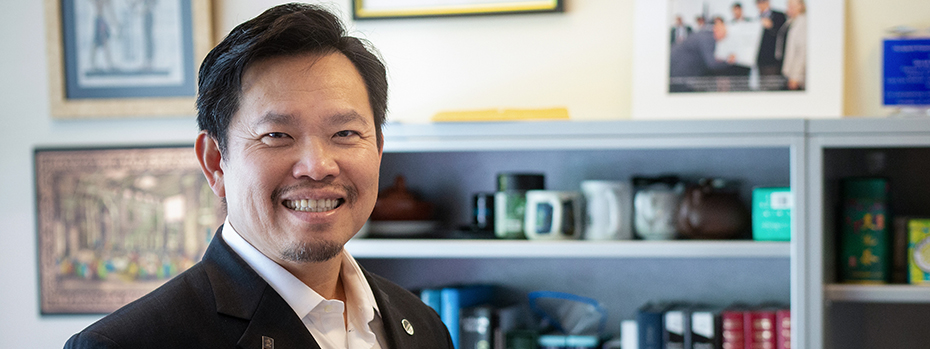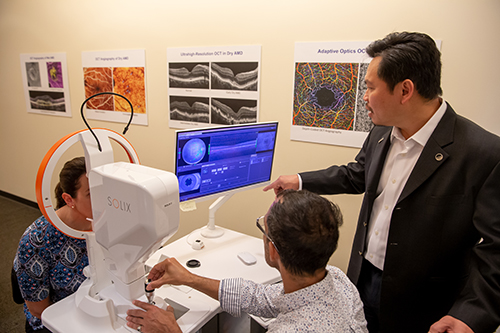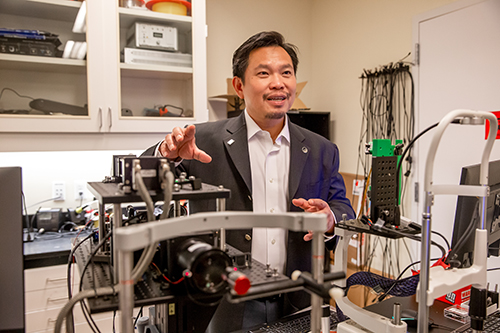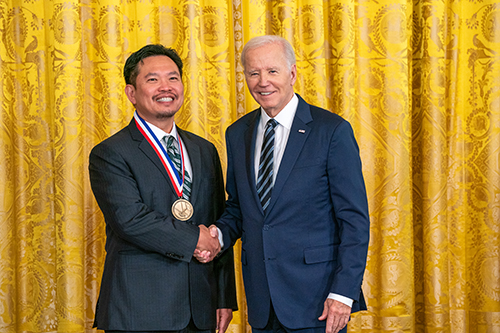Meet Dr. David Huang

His groundbreaking work saves eyesight for millions
Millions of people have avoided blindness because of Dr. David Huang, associate director and director of research at the OHSU Casey Eye Institute.
Huang, M.D., Ph.D., helped invent a quick, painless scan that creates highly detailed 3D images of the retina in the back of the eye. These images can reveal potential signs of disease, sometimes years before patients notice symptoms. As a result, patients can receive early care that prevents or reduces vision loss.
The life-changing scan is called OCT, short for optical coherence tomography. It’s used in more than 40 million eye exams worldwide each year. It has saved patients and the U.S. government’s Medicare program billions of dollars in treatment costs.

Strong role models
Dr. Huang was born in Taiwan and moved to the United States with his family when he was 12. His father was a doctor, which inspired him to pursue a medical career. He credits his high school chemistry teacher, Dr. Terry Peard, with guiding his science fair project and college applications.
Dr. Huang attended the Massachusetts Institute of Technology, where he earned bachelor’s and master’s degrees in electrical engineering. At MIT, he met Dr. Raphael Lee, who became a role model for balancing patient care and scientific research. Dr. Lee recommended Dr. Huang for the Harvard-MIT MD-PhD Program in Health, Sciences and Technology.
A life-changing assignment
As a Ph.D. student, Dr. Huang joined Dr. James Fujimoto’s optics lab at MIT. Dr. Huang was assigned to a project on interferometry, which uses light waves to make highly precise measurements.
The project team tested interferometry on eye tissue. The second tissue they looked at was the retina, whose layered structures inspired the idea for optical coherence tomography. After developing and testing the technology, the team introduced OCT to the world in a paper published in 1991, when Dr. Huang was 27.
“I was extraordinarily lucky at the start of my career,” he said in his 2023 acceptance speech for the Lasker Award, considered America’s Nobel Prize.
A technology with many uses
Since its introduction a generation ago, optical coherence tomography has gone from an idea in a lab to a standard of care around the world. Hundreds of companies are making OCT systems and parts. Thousands of researchers are exploring new ways to use this noninvasive technology.
Heart specialists use OCT to measure plaque in arteries and decide on treatment. Dermatologists use it to diagnose skin cancer without biopsies (removing tissue). Dentists use it to detect cavities and gum disease, and to assess the soundness of fillings, crowns and other dental work.
At OHSU, Dr. Huang’s professional home since 2010, he leads a 40-member team at the Center for Ophthalmic Optics and Lasers that continues to refine OCT.
The “COOL Lab,” as the team calls itself, has developed OCT angiography, which maps blood flow in the eye to check for abnormal vessels or lack of flow. Lab members are working on OCT optoretinography, which measures the retina's response to light to see how well its cells work. This could boost early detection and management of retina conditions that cause vision loss.
“The OCT field has attracted many of the brightest minds because it combines interesting physics, beautiful images and sight- or lifesaving applications,” Dr. Huang said at the Lasker ceremony.

A scientific and medical legacy
Dr. Huang holds 44 patents. He has published more than 350 peer-reviewed scientific articles that other scientists have cited more than 66,000 times. He is a founder of GoCheck, whose GoCheck Kids smartphone app has been used to screen over 6 million children for an eye condition called amblyopia. He is a professor of ophthalmology and biomedical engineering.
And he still sees patients one day a week.
In a 2023 interview for the OHSU Oral History Program, Dr. Huang said retina care once was “a dismal subspecialty where you just watched patients go blind.”
That’s no longer the case. “I am proud that millions of people have benefited from a technology that I helped invent three decades ago.”

Learn more about Dr. Huang
- Oregon History Makers: Dr. David Huang, physician at OHSU, Oregon History Makers: Dr. David Huang, physician at OHSU, KGW TV, October 2024
- The Ophthalmologist Power List Hall of Fame, The Ophthalmologist, August 2024
- OHSU researcher wins prestigious medical honor for technology that can save sight, The Oregonian/OregonLive, September 2023
- Co-invented by OHSU's Dr. David Huang 25 years ago, OCT technology helps detect and stop blindness, The Lund Report, July 2016
Awards
Dr. Huang has won prominent awards, including:
- The Lasker-DeBakey Clinical Medical Research Award
- The National Medal of Technology and Innovation
- The Sanford and Susan Greenberg Prize to End Blindness
- The Fritz J. and Dolores H. Russ Prize from Ohio University
- The António Champalimaud Vision Award
- The Oregon History Maker award from the Oregon Historical Society
Memberships
Dr. Huang has been elected to:
- The National Academy of Engineering
- The National Academy of Inventors
- The National Academy of Medicine
- The National Inventors Hall of Fame
Resources for media
Download photos and other resources about Dr. Huang.